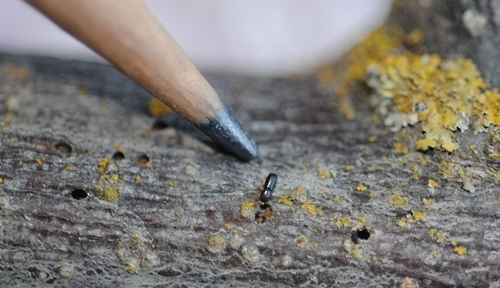
UC Davis entomology doctoral student Stacy Hishinuma has received and accepted a position in the USDA Pathways Internship Program with the Region 5 field office of the USDA Forest Service, San Bernardino.
Hishinuma studies the walnut twig beetle, Pityophthorus juglandis, which in association with a newly described fungus, Geosmithia morbida, causes thousand cankers disease (TCD) of walnut and butternut trees.
The walnut twig beetle is believed to be native to Arizona, California, New Mexico and Mexico. In 2006, plant pathologist Ned Tisserat and entomologist Whitney Cranshaw of Colorado State University identified the pathogen in declining black walnut trees in central Colorado. The disease has now spread east of the Mississippi to states in the heart of the valuable black walnut timberlands. Most recently it was reported from Indiana. Latest collection records show that the beetle and pathogen are now known from nine states in the western United States and seven states in the eastern USA. In 2013 the disease was also reported in Italy marking the first time that it occurred in Europe.
Hishinuma works with major professor Mary Louise Flint and is co-advised by chemical ecologist and forest entomologist Steve Seybold of the Pacific Southwest Research Station, USDA Forest Service, Davis, an affiliate of the department. Flint is an Extension specialist emeritus with the UC Davis Department of Entomology and Nematology and a former associate director with the UC Integrated Pest Management Program.
“USDA will provide some financial support during the end stages of her Ph.D. thesis, in exchange for 320-640 hours of work and training over the next 14 months,” said Seybold. Then, in June 2016 her position will be converted to that of a permanent entomologist with the USDA Forest Service office in San Bernardino after she has completed her thesis. She will be responsible for forest insect survey, detection, and management on four national forests in southern California ranging from San Diego to Monterey counties.
“The highly competitive internship and guaranteed position are a credit to her and her achievements,” Seybold said.
Seybold and Flint assisted her in developing the internship, as did Richard “Rick” Bostock, UC Davis professor of plant pathology.
Hishinuma won the 2013 Western Forest Insect Work Conference Memorial Scholarship for her research on TCD and presented her work at group's 65th annual conference, held March 31-April 3, 2014 in Sacramento. She also received two scholarships from the California Garden Clubs, Inc. (CGCI) and a McBeth Memorial Scholarship to support her research on TCD.
Seybold's research group has led the effort to characterize the disease in California and to develop a nationwide detection program for the beetle. They recently published two papers in the journal PLOS ONE that characterize the genetic diversity and invasion patterns of both the pathogenic fungus and the beetle in the United States. Scientists believe that TCD occurs only on walnut, butternut, and wingnut, but it is most damaging to native black walnuts, Juglans californica, J. hindsii, and J. nigra although the disease has been recorded on at least 10 species of walnuts or their hybrids in California. Often the first symptoms of TCD are flagging and yellowing leaves and branch dieback, Seybold said. Affected branches show sap staining and pinhole-sized beetle holes. Beneath the surface are dark stains caused by the funguhe news is startling, but not totally unexpected.
Attached Images:
